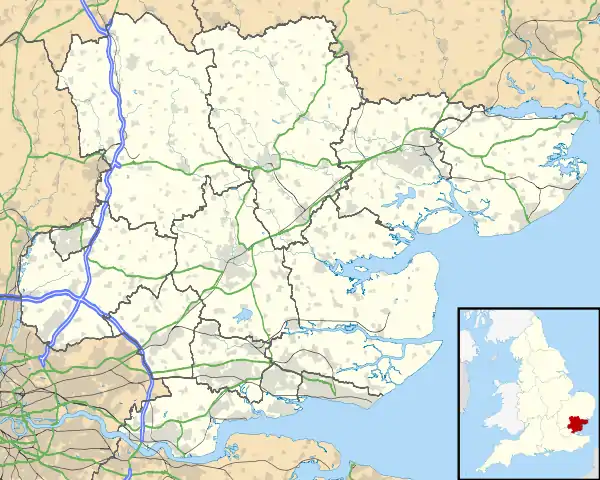| Hatfield Broad Oak | |
|---|---|
 The Church of St Mary the Virgin | |
 Hatfield Broad Oak Location within Essex | |
| Population | 904 [1] |
| OS grid reference | TL546166 |
| • London | 25 mi (40 km) SW |
| District | |
| Shire county | |
| Region | |
| Country | England |
| Sovereign state | United Kingdom |
| Post town | Bishop's Stortford |
| Postcode district | CM22 |
| Dialling code | 01279 |
| Police | Essex |
| Fire | Essex |
| Ambulance | East of England |
| UK Parliament | |
Hatfield Broad Oak (also known as Hatfield Regis[2]) is a village and civil parish in the Uttlesford district of Essex, England. The village is approximately 5 miles (8 km) south-east of Bishop's Stortford. Near the church of St Mary the Virgin is former Benedictine priory Hatfield Regis Priory.
History
Traces of Bronze Age occupation have been found in the parish, including the Portingbury Hills mound in Hatfield Forest.[3]
The settlement of Hatfield was well established by the time of the Norman Conquest and its Domesday Book population of 115 put it as the ninth largest settlement in Essex.[4] At one time a royal manor of Harold I, it fell under the possession of William I.[4] Popular for hunting in the neighbouring forest, its royal patronage led to its becoming known as Hatfield Regis, or King's Hatfield, partly to distinguish it from Hatfield Peverel, also in Essex.[5]
By the time the priory was dissolved, the town had over 1000 residents.[3]
The name Hatfield Broad Oak has been used since at least 1136, and the eponymous oak was mentioned in record in 1295. The forest still contains the fenced remains of a very large oak known as the "Doodle Oak", estimated as 850 years old, though it is believed to be a different tree to that which gave the parish its name. Hatfield Forest, is an ancient woodland, a Site of Special Scientific Interest (SSSI) and a National Nature Reserve (NNR). It is now in the possession of the National Trust.[3] The modern hedges in Hatfield Broad Oak still follow the boundaries the ancient forest following clearances known as assarting.[6] A phonetic version of the name might be that recorded in 1381 as "Hatfeld Broodhook"[7]
Hatfield was at one time a thriving market town. At the time of the 2001 Census it had a population of 1,600.[8] By the 2021 census, the population had declined to 904.
Community
At around 8,800 acres (36 km2) the parish is one of the largest in Essex, stretching 4 miles (6 km) north of the village, and was formerly divided into four "quarters": Town Quarter, Woodrow Quarter, Heath Quarter, and Broomsend Quarter. At the north end of the parish lies Hatfield Forest, known for its large oak trees.[9] Approximately 1 mile (1.6 km) to the north of the village, and included in the parish, is the small village of Bush End, with its church, the Grade II listed St John the Evangelist, which dates to 1856.[10]
The Cock Inn, a public house, dates to the fifteenth century.[3]
St Mary's Church of England primary school was opened in 1816 as a National school.
Each May Bank holiday a 10 kilometre road race is held using a course running around the village.[11]
Church
A Saxon church was present in Hatfield at the time of the Domesday Book. The present parish church of St Mary the Virgin is early medieval, and has a stone tower with eight bells. The largest weighs 17cwt and was cast in 1782 by Patrick & Osborn, a private bell foundry, who at the time worked in direct competition to Whitechapel Bell Foundry.
The parish church was at one time part of the priory church but was rebuilt for separate parochial use towards the end of the fourteenth century and extended over the next century.[3]
The nave contains the mutilated stone effigy of Robert de Vere, 3rd Earl of Oxford, who was buried in the church in 1221. The writings belonging to the Barrington family of Barrington Hall are deposited in the north vestry; which is believed to have been part of the priory chapel. In the other vestry is a library, placed there in 1708, by Sir Charles Barrington.[9]
Governance
Hatfield Broad Oak is part of the electoral ward called Broad Oak and the Hallingburys. The population of this ward at the 2011 census was 3,571.[12]
See also
References
- ↑ https://www.citypopulation.de/en/uk/eastofengland/essex/E63004287__hatfield_broad_oak/
- ↑ Hatfield Broad Oak Essex through time: Local history overview
- 1 2 3 4 5 W. R. Powell (1983). A History of the County of Essex: Volume 8. Victoria County History.
- 1 2 Open Domesday Online: Hatfield (Broad Oak), accessed January 2019.
- ↑ "The Monastery of Hatfield Regis", Rev. Alan Jones. Displayed in Hatfield Broad Oak church
- ↑ Barker, Hugh Hedge Britannia 2012 Bloomsbury, London p26-7
- ↑ Plea Rolls of the Court of Common Pleas; CP40/483; year 1381; http://aalt.law.uh.edu/AALT6/R2/CP40no483/483_0748.htm; second entry, second line
- ↑ Local Area Population and Ethnicity - Hatfield Broad Oak in Essex - Town-Guides.org Archived 5 September 2008 at the Wayback Machine
- 1 2 White's Directory of Essex, 1848
- ↑ Historic England. "Church of St John the Evangelist (1186259)". National Heritage List for England. Retrieved 14 June 2014.
- ↑ Hatfield Broad Oak 10k Road Race and 1 mile Fun Run
- ↑ "Broad Oak and the Haslingburys ward population 2011". Retrieved 26 September 2015.
External links
 Media related to Hatfield Broad Oak at Wikimedia Commons
Media related to Hatfield Broad Oak at Wikimedia Commons- Village web site
- St Mary's Primary School
- Hatfield Forest web site